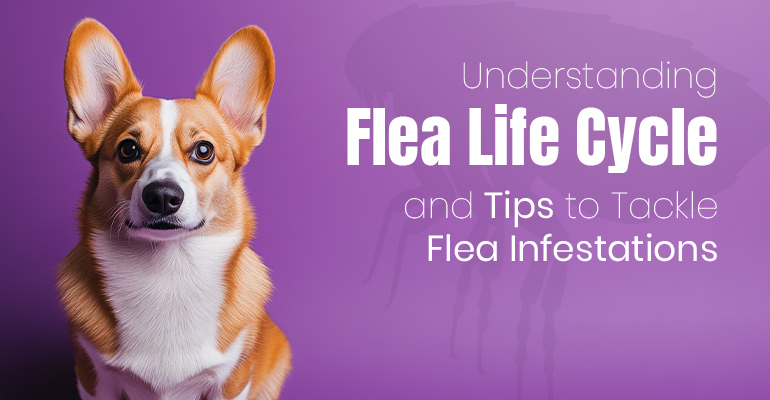Understanding Flea Life Cycle & Tips to Tackle Flea Infestations

Are fleas giving you and your pets a headache, and you want to get rid of them, but not sure how? Fret not! We are here to help. Fleas are not just an annoyance, but a matter of concern for pet parents due to their ability to cause a range of problems; pain, irritation, and harmful diseases to specify a few.
In this blog post, we will discuss everything about fleas, from their life cycle to the diseases they cause. Let’s dive into the details.
What Are Fleas & How Do They Infest Pets?
Fleas are flat, tiny, wingless parasites that feed on the blood of their host and cause life-threatening diseases. These blood-sucking parasites thrive in warm temperatures and jump from one place to another in search of a host.
Fleas are everywhere and can attack your pet both indoors and outdoors, hiding in bushes, grass, beddings, furniture and carpets. Moreover, female fleas can lay 20-50 eggs a day, which can multiply quickly, making the infestation severe and difficult to get rid of.
Flea Life Cycle

Understanding the Flea Life Stages
Let’s have a quick rundown on the different life stages of fleas:
- Eggs: Flea eggs are tiny, white-colored, oval-shaped, and fall off easily on the ground after being laid on the host because of their non-sticky texture. They can also fall in the environment and remain hidden in places such as beddings, carpets, etc., leading to infestations post-hatching. They hatch within 2-10 days, depending on the temperature.
- Larvae: Flea larvae hatch from the eggs within 5-10 days and have a whitish, maggot-like appearance. They have no eyes and legs and turn dark in color as they feed on the feces excreted by adult fleas and their skin cells. They thrive in humid temperatures and tend to hide in bedding, carpets, leaves, etc.
- Pupae: Flea pupae wrap themselves in a cocoon to protect themselves and emerge as adult fleas. They have a sticky texture, which helps them blend, hide and survive for weeks to months till they finally hatch into adults. Flea pupae are more resistant to various environmental conditions and treatments.
- Adult Fleas: Adult fleas emerge from the pupae and find a suitable host to survive for 2 months. They not only cause pain, irritation and discomfort but also transmit harmful diseases. Therefore, it is essential to use effective flea preventive treatments to keep your pet protected.
Diseases Caused by Fleas
Mentioned below are some common diseases caused by fleas in pets:
Cat Scratch Disease:
Cat scratch disease, also known as Cat scratch fever, is a bacterial infection caused by the bacterium Bartonella henselae through flea bites, leading to vomiting, swollen lymph nodes, fever, lethargy, etc.
Tapeworm Infestation:
Tapeworms are intestinal worms that are carried by fleas and can infect cats and dogs, causing weight loss, anemia, vomiting, etc. Tapeworms are transmitted in pets by ingestion of flea larvae during grooming or playing.
Anemia:
Fleas feed on their host’s blood. Prolonged, untreated infestation causes significant blood loss, leading to anemia. Pale gums, weight loss, lethargy and increased heart rate are some of the common symptoms of anemia.
Flea allergy dermatitis:
Flea allergy dermatitis is an allergic reaction to the skin caused by flea saliva. It is often accompanied by itching, irritation, and hair loss.
Simple Ways to Break the Flea Life Cycle
Here are some easy yet effective ways to break the flea life cycle and keep your pets safe and healthy:
- Use flea treatments: Adopting year-round flea treatments for your pet is one of the most effective ways to keep them protected. There are various flea and tick preventions available in the market in different forms, such as oral, topical, collars, etc. Choose the one that suits your pet’s requirements and preferences.
- Focus on hygiene: Keeping your home clean and tidy plays a significant role in preventing all flea life stages and safeguarding your pet from harmful diseases. Fleas hide inside the beddings and furniture and multiply quickly. Therefore, vacuum the beddings and carpets regularly and keep your pet’s environment hygienic.
- Mow your lawn: Fleas tend to hide inside the bushes, leaves and woods and can attack your pet when they are enjoying their playtime. Therefore, focus on keeping your lawn trimmed to ensure fleas stay away from your pet.
- Ensure regular grooming: Keeping your pet well-groomed plays a huge role in deterring fleas and preventing them from staying in the fur. Consider grooming your pets regularly with a flea comb to remove adult fleas and maintain the overall health of your furball.
- Routine vet visits: Taking your pet for routine wellness examinations may help detect any potential problems at an early stage and provide timely treatment to your beloved companion.
Wrapping Up
All in all, fleas are annoying parasites that not only cause pain and discomfort but also carry the potential to transmit deadly diseases. Hence, it is essential to have a complete understanding of fleas, their life cycle and diseases caused by them so that you can stay informed and keep your furry companion hale and hearty. Equip yourself with the information mentioned in this blog and follow the tips to keep fleas away from your pet and your home. Get affordable and reliable flea preventives online to ensure the vitality and longevity of your fluffballs.




